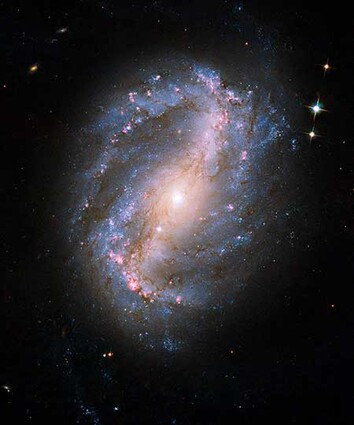Stars over Sisters 5/31/2022
Last updated 5/31/2022 at Noon

COURTESY NASA
NGC 4316 is a barred spiral galaxy located 46 million light-years away in the constellation of Ursa Minor.
June brings with it the beginning of summer here in the Northern Hemisphere, a good news/bad news proposition for evening stargazers. The likelihood of clearer skies and warmer temperatures than spring delivered is the upside, but the later-setting sun delays nighttime observing. When it does get dark enough to see stars, look for our featured constellation.
No other stellar grouping is less dependent on the season of the year to be seen than Ursa Minor, also known as the Little Bear or Little Dipper. This is because Polaris (the North Star) marks the end of the dipper’s handle, a point in the sky about which all stars north of the celestial equator appear to revolve. To find Polaris, locate the Big Dipper and extend a line that passes through the end two stars of the Big Dipper’s “cup.”
Shining at a magnitude of 2.0, Polaris is the constellation’s brightest star. Classified as a yellow-white supergiant, it is bigger, brighter, and more massive than our sun. Polaris lies 432 light-years from earth.
Although Ursa Minor is nearly devoid of deep-sky objects, there is one impressive exception. NGC 6217 is a beautiful barred spiral galaxy located approximately 67 million light-years away. It is a starburst galaxy, meaning it is undergoing a high rate of star formation.
There are various stories in Greek mythology that refer to Ursa Minor. In one, Ursa Minor is Ida, a nymph who cared for Zeus when he was born. Ida helped hide Zeus away in a cave from his father, who wanted to kill him in fear of being overthrown. In return for taking care of him, Zeus rewarded Ida by turning her into the constellation Ursa Minor.
For those who live at latitudes north of the equator, summer begins at 2:13 a.m. on June 21. At that time, the sun will reach its highest point in the sky, appearing directly overhead on the Tropic of Cancer.
June will host a blockbuster planetary display! In the predawn skies, all seven major planets of the solar system will align themselves throughout the month (yes, Uranus and Neptune will be there too, though not considered naked-eye objects.) The best time to observe this planetary parade will be on the morning of June 24 when a waning crescent moon will enhance the picturesque scene. Beginning at about 4:30 a.m. the planets will be in a nearly straight line, beginning with Mercury nearest the horizon, Venus, Uranus, the moon, Mars, Jupiter, Neptune, and Saturn, well up above the southern horizon.
Because of the late-May new moon, our only natural satellite will wax until June 14 when the Full Strawberry Moon arrives. In parts of Europe, June’s full moon is sometimes referred to as the Full Rose Moon. Since the moon will make its closest monthly approach to the earth on the same day, it will also be a supermoon, appearing slightly larger than an average sized moon. From June 21 (last quarter) through the end of the month, the moon will be absent from evening skies and providing wonderful star-viewing conditions.
Our dark-sky tip for this month is to use outdoor lights that produce warm colors. When shopping for lights, look for lamps rated at 2700 Kelvin or lower. Humans and animals are negatively affected by blue light. Our internal clock, or circadian rhythm, determines when we go to sleep and wake up. Cooler colored light can make it very difficult to fall asleep, while warmer colors don’t affect us as much. Animals living around us are also affected, so it’s important to be conscious of our outdoor light usage.










Reader Comments(0)